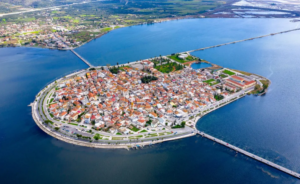A hot wind buffeted the slate-grey lagoon waters as I followed a bearded priest on a moped – black robes flapping like crow’s wings. We were heading across one of the two narrow bridges linking Aitoliko’s old town with its newer half, on the mainland. Most countries have their “Little Venice”, and Aitoliko is Greece’s very own watery slice of La Serenissima.
Seen from above, this lagoon-surrounded islet, loosely moored to the mainland by its slender crossings and bisected by narrow streets that were once canals, it certainly looks the part. Even from ground level, as the setting sun caught the gondola-like priari fishing boats bobbing in the harbour, there was more than a passing resemblance.
The streets where I stretched my legs after the long and bumpy drive from Preveza’s tiny airport could have belonged to any remote town in Greece, however. Heading for Monomatos taverna behind the Panagia church (where Greek revolutionary Georgios Karaiskakis was tried for treason in 1824), I detected blissful holiday odours of suntan cream, custardy bougatsa and olive oil.
Diving into a web of streets, I passed shops selling evil eye pendants and plaster ballerinas next to pressure cookers and juicers; there were dogs sleeping beneath shop fronts with signs picked out in 1950s-style ceramics; Katzogia, a pastry shop, had family photos on the walls; the butcher’s store had a three-legged wooden chopping block varnished with gore.
“When you cross the bridge you are in another world,” said Georgios, the owner of Monomatos, a spit-and-sawdust taverna with wooden floors and chequered table cloths that has been serving fresh seafood for 80 years. “It’s small, but we have everything we need: post office, shops, banks – there’s even a police station.”
His menu included grilled grey mullet, bottarga and smoked eel. His larder is the Mesolongi-Aitoliko Lagoon National Park, listed on Greece’s national index of Intangible Cultural Heritage, and where many age-old fishing practices are still in use.
Continue here: The Telegraph
Ask me anything
Explore related questions





